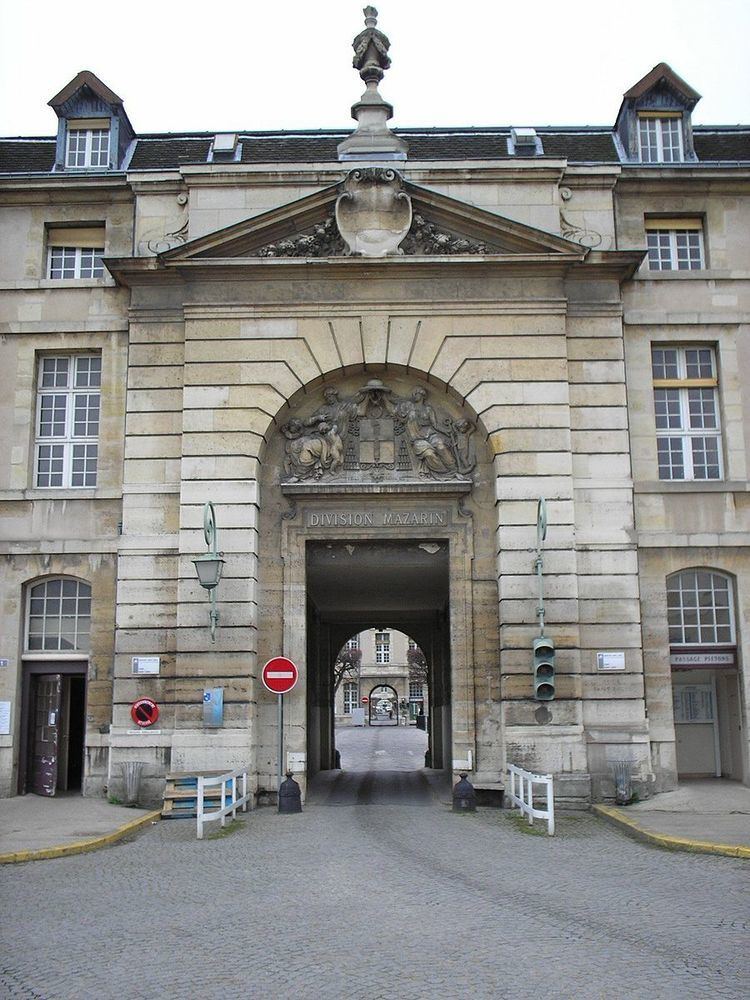Location Paris, France Hospital type Teaching Beds 1,603 Opened 1670 | Care system Public Emergency department Yes Phone +33 1 42 16 00 00 | |
 | ||
Similar Assistance Publique – Hôpitaux, Lariboisière Hospital, Hôpital Cochin, Hôpital Saint‑Louis, Hôtel‑Dieu de Paris Profiles | ||
Cctv piti salp tri re hospital 31st aug 1997
The Pitié-Salpêtrière University Hospital (Hôpital universitaire Pitié-Salpêtrière) is a celebrated teaching hospital in the 13th arrondissement of Paris. Part of the Assistance publique – Hôpitaux de Paris and a teaching hospital of Sorbonne University, it is one of Europe's largest hospitals.
Contents
- Cctv piti salp tri re hospital 31st aug 1997
- History
- Hospital Chapel
- Philippe Pinel monument
- Notable doctors
- References
History
The Salpêtrière was originally a gunpowder factory ("salpêtre" being a constituent of gunpowder), but in 1656 at the direction of Louis XIV, it was converted into an hospice for the poor of Paris. It served as a prison for prostitutes, and a holding place for the mentally disabled, criminally insane, epileptics, and the poor; it was also notable for its population of rats. Although the Pitié-Salpêtrière was much admired for the architectural ambitions of Libéral Bruant, it provided unsatisfactory living conditions for its inhabitants. The building was enlarged in 1684.
By the eve of the Revolution, it had become the world's largest hospital, with a capacity of 10,000 patients plus 300 prisoners, largely prostitutes swept from the streets of Paris. From La Salpêtrière they were paired with convicts and forcibly expatriated to New France.
During the September massacres of 1792, the Salpêtrière was stormed on the night of 3/4 September by a mob from the impoverished working-class district of the Faubourg Saint-Marcel, with the avowed intention of releasing the detained street-girls; 134 of the prostitutes were released; twenty-five madwomen were less fortunate and were dragged, some still in their chains, into the streets and murdered.
In the first half of the 19th century, the early humanitarian reforms in the treatment of the mentally ill were initiated here by Philippe Pinel (1745 - 1826), friend of the Encyclopédistes; his sculptural monument stands before the main entrance in Place Marie-Curie, Boulevard de L'Hôpital. Pinel was the chief physician at the Salpêtrière by 1794, in charge of a 200-bed infirmary. He was succeeded by his assistant Jean-Étienne Dominique Esquirol (1772 - 1840) who, in 1817, had initiated the first systematic lectures on psychiatry in France. Esquirol was also the chief architect of the French Lunacy legislation of 1838.
A regular visitor to the Salpêtrière from 1842 till his death more than thirty years later was Guillaume-Benjamin Duchenne de Boulogne (1806 - 1875). A strange and reclusive figure who held no senior appointment in the hospital, Duchenne nevertheless made extensive and meticulous observations on neurological problems, employing a wide range of innovative diagnostic techniques. Duchenne's clinical science stood at the crossroads of physiology, electricity, photography and psychology, as recorded in his much admired De l'électrisation localisée with its associated atlas Album de photographies pathologiques (1855, 1862). His name is commemorated in the myopathies which he described, as well as in his 1862 masterpiece, the Mécanisme de la physionomie humaine, much consulted by Charles Darwin in his work on human evolution and emotional expression, set out in his Expression of the Emotions in Man and Animals (1872). Later, when Jean-Martin Charcot (1825 - 1893) took over the department, the Salpêtrière became known as a psychiatric centre. Charcot had absorbed much from Duchenne (to whom he always referred as "mon maître, Duchenne") and his teaching activities on the Salpêtrière's wards helped to elucidate the natural history of many diseases including neurosyphilis, epilepsy, and stroke. Students came from all across Europe to listen to Charcot's lectures and clinical demonstrations: among them - in 1885 - was the 29 year old Sigmund Freud whose deconstruction of Charcot's lectures on hypnosis and hysteria formed the foundations of psychoanalysis.
The Hôpital de la Pitié, founded about 1612, was moved next to the Salpêtrière in 1911 and fused with it in 1964 to form the Groupe Hospitalier Pitié-Salpêtrière. The Pitié-Salpêtrière is now a general teaching hospital with departments focusing on most major medical specialities.
Numerous celebrities have been treated at the Salpêtrière, including Michael Schumacher, Ronaldo, Prince Rainier of Monaco, Alain Delon, Gérard Depardieu, and Valérie Trierweiler. Former president Jacques Chirac had a pacemaker fitted at the Salpêtrière in 2008. Celebrities have also died at the Pitié-Salpêtrière, including the singer Josephine Baker in 1975, following a cerebral haemorrhage; philosopher Michel Foucault (from complications of AIDS) on 25 June 1984; Diana, Princess of Wales in 1997; and French bicycle racer Laurent Fignon in 2010 (from the metastatic spread of lung cancer).
Hospital Chapel
Chapelle de la Salpêtrière (Hospital Chapel), at n° 47 Boulevard de l'Hôpital is one of the masterpieces of Libéral Bruant, architect of Les Invalides. It was built around 1675, on the model of a Greek cross and has four central chapels each capable of holding a congregation of some 1,000 people. Its central octagonal cupola is illuminated by picture windows in circular arcs.
Philippe Pinel monument
In the place in front of the main entrance to the Hospital, there is a large bronze monument to Philippe Pinel, who was chief physician of the Hospice from 1795 to his death in 1826. The Salpêtrière was, at the time, like a large village, with seven thousand elderly indigent and ailing women, an entrenched bureaucracy, a teeming market and huge infirmaries. Pinel created an inoculation clinic in his service at the Salpêtrière in 1799 and the first vaccination in Paris was given there in April 1800.
Notable doctors
Through its history, the Pitié-Salpétrière hosted notable doctors, among others:
